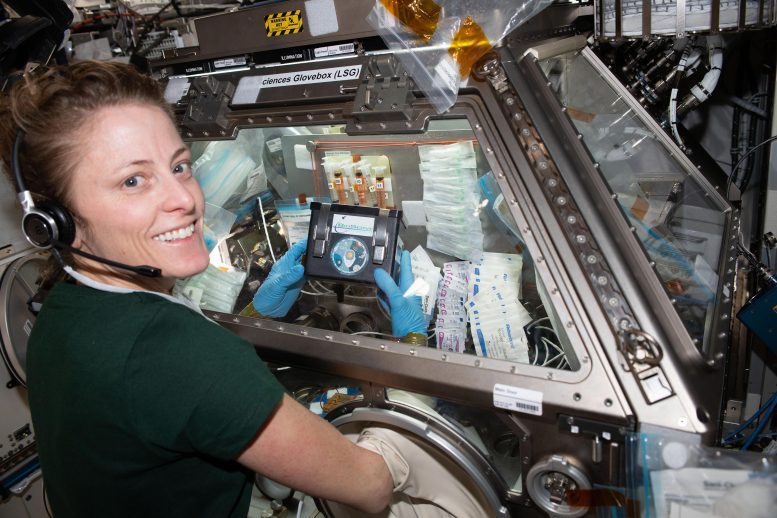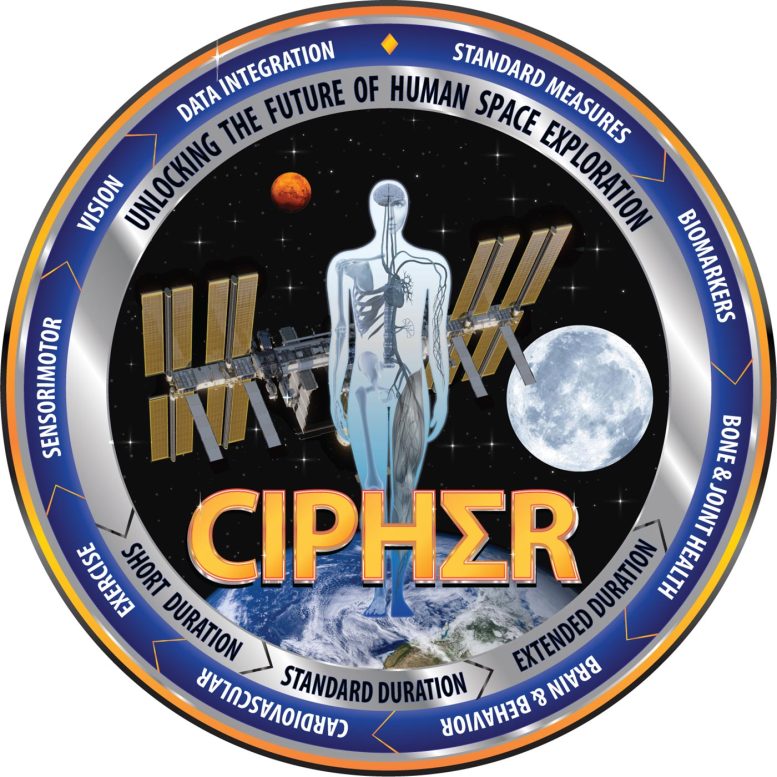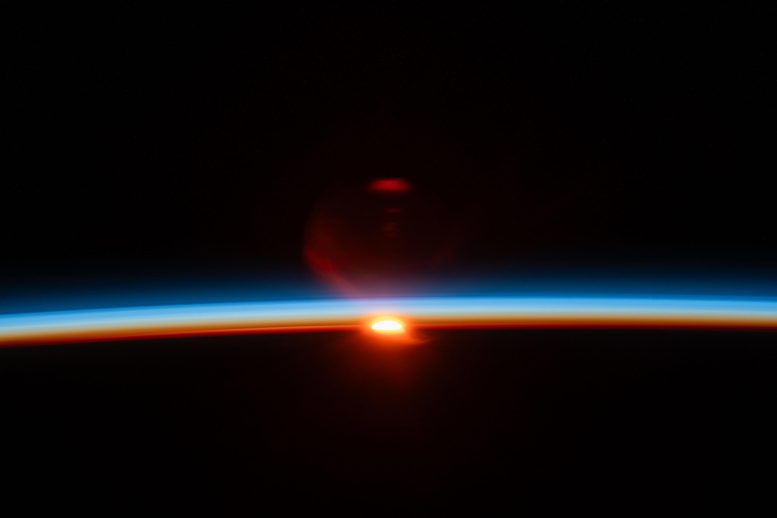Space Station Astronauts Conduct Stem Cell Science and Human Research Ahead of Cargo Arrival
The sun’s last rays illuminate Earth’s atmosphere and refract in the camera lense in this photograph of an orbital sunset from the International Space Station as it soared 261 miles above the Pacific Ocean off the northern coast of Japan. Credit: NASA
A cargo craft loaded with nearly three tons of food, fuel, and supplies is currently in orbit heading to the International Space Station, targeting early Saturday for docking. As the Expedition 70 crew members await the arrival of Progress 87, stem cell science, heart rate data collection, and eye exam activities topped their research schedule on Thursday.
Progress 87 successfully launched from the Baikonur Cosmodrome in Kazakhstan at 10:25 p.m. EST Wednesday, February 14. On Saturday, February 17, the cargo craft will automatically dock to the aft port of the Zvezda service module at 1:12 a.m., with cosmonauts Oleg Kononenko and Nikolai Chub on duty to monitor the spacecraft’s arrival.

NASA astronaut and Expedition 70 Flight Engineer Loral O’Hara treats brain cell-like samples inside the Kibo laboratory module’s Life Science Glovebox aboard the International Space Station. She was processing the samples for the Cerebral Ageing space biology study that is exploring the degenerative processes of brain cells. Results may provide insights into accelerated aging symptoms seen in space and neurodegenerative diseases experienced on Earth. Credit: NASA
Aboard the station, four orbital residents spent most of the day on the Mesenchymal Stem Cells in Microgravity Induced Bone Loss (MABL-A) investigation. MABL-A—delivered aboard Northrop Grumman’s 20th Commercial Resupply Mission—assesses the effects of microgravity on bone marrow stem cells. In the morning, NASA astronaut Loral O’Hara collected BioCell samples inside the habitat with assistance from JAXA (Japan Aerospace Exploration Agency) Flight Engineer Satoshi Furkawa. In the afternoon, NASA astronaut Jasmin Moghbeli took over the BioCell sampling work with assistance from ESA (European Space Agency) Commander Andreas Mogensen.
Mogensen also spent part of the day photographing Plant-Microbe Interactions in Space (APEX-10) petri plates—another investigation that launched aboard Northrop Grumman’s 20th resupply mission—to examine whether beneficial microbes can mitigate some of the negative effects the space environment can have on plant growth and development.

Astronauts headed to the International Space Station can now sign up for a broad suite of experiments that will help scientists pinpoint how the human body reacts to long-duration missions in space. The research will help NASA prepare astronauts for missions to the Moon, Mars, and beyond. Credit: NASA
In the afternoon, O’Hara conducted an array of activities for the CIPHER investigation, including the collection of heart rate data and completing an eye exam. CIPHER, or Complement of Integrated Protocols for Human Exploration Research, is an all-encompassing, total-body approach that examines how humans adapt to spaceflight.
In the Roscosmos segment, Chub worked with Flight Engineer Konstantin Borisov to film an educational video that demonstrates the capabilities of Roscosmos scientific hardware aboard the station. Meanwhile, Kononenko conducted some routine maintenance in the Zarya module. Near the end of the day, Borisov examined the Earth’s nighttime atmosphere in near-ultraviolet for an ongoing investigation aboard the orbital lab.

The sun’s last rays illuminate Earth’s atmosphere and refract in the camera lense in this photograph of an orbital sunset from the International Space Station as it soared 261 miles above the Pacific Ocean off the northern coast of Japan. Credit: NASA
A cargo craft loaded with nearly three tons of food, fuel, and supplies is currently in orbit heading to the International Space Station, targeting early Saturday for docking. As the Expedition 70 crew members await the arrival of Progress 87, stem cell science, heart rate data collection, and eye exam activities topped their research schedule on Thursday.
Progress 87 successfully launched from the Baikonur Cosmodrome in Kazakhstan at 10:25 p.m. EST Wednesday, February 14. On Saturday, February 17, the cargo craft will automatically dock to the aft port of the Zvezda service module at 1:12 a.m., with cosmonauts Oleg Kononenko and Nikolai Chub on duty to monitor the spacecraft’s arrival.

NASA astronaut and Expedition 70 Flight Engineer Loral O’Hara treats brain cell-like samples inside the Kibo laboratory module’s Life Science Glovebox aboard the International Space Station. She was processing the samples for the Cerebral Ageing space biology study that is exploring the degenerative processes of brain cells. Results may provide insights into accelerated aging symptoms seen in space and neurodegenerative diseases experienced on Earth. Credit: NASA
Aboard the station, four orbital residents spent most of the day on the Mesenchymal Stem Cells in Microgravity Induced Bone Loss (MABL-A) investigation. MABL-A—delivered aboard Northrop Grumman’s 20th Commercial Resupply Mission—assesses the effects of microgravity on bone marrow stem cells. In the morning, NASA astronaut Loral O’Hara collected BioCell samples inside the habitat with assistance from JAXA (Japan Aerospace Exploration Agency) Flight Engineer Satoshi Furkawa. In the afternoon, NASA astronaut Jasmin Moghbeli took over the BioCell sampling work with assistance from ESA (European Space Agency) Commander Andreas Mogensen.
Mogensen also spent part of the day photographing Plant-Microbe Interactions in Space (APEX-10) petri plates—another investigation that launched aboard Northrop Grumman’s 20th resupply mission—to examine whether beneficial microbes can mitigate some of the negative effects the space environment can have on plant growth and development.

Astronauts headed to the International Space Station can now sign up for a broad suite of experiments that will help scientists pinpoint how the human body reacts to long-duration missions in space. The research will help NASA prepare astronauts for missions to the Moon, Mars, and beyond. Credit: NASA
In the afternoon, O’Hara conducted an array of activities for the CIPHER investigation, including the collection of heart rate data and completing an eye exam. CIPHER, or Complement of Integrated Protocols for Human Exploration Research, is an all-encompassing, total-body approach that examines how humans adapt to spaceflight.
In the Roscosmos segment, Chub worked with Flight Engineer Konstantin Borisov to film an educational video that demonstrates the capabilities of Roscosmos scientific hardware aboard the station. Meanwhile, Kononenko conducted some routine maintenance in the Zarya module. Near the end of the day, Borisov examined the Earth’s nighttime atmosphere in near-ultraviolet for an ongoing investigation aboard the orbital lab.
